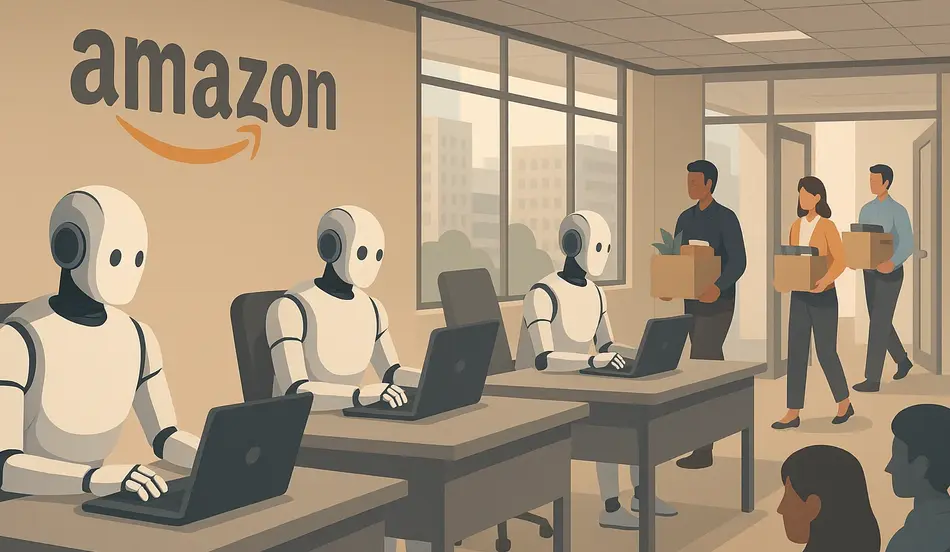Amazon is embarking on one of the most ambitious corporate automation drives in Silicon Valley history. Over the next 12–18 months, the tech giant expects to eliminate several thousand white‑collar roles across finance, human resources, marketing, operations and vendor management, replacing them with artificial‑intelligence systems capable of handling a range of administrative, analytical and customer‑support functions. The move—driven by internal pilots that have proven AI’s ability to execute routine workflows faster, more consistently and at lower cost—signals a profound shift in how knowledge‑work happens at scale.
1. Why AI—and Why Now?
1.1 Maturation of Generative AI
Amazon’s leadership has watched internal generative‑AI experiments evolve from crude text‑completion tools into sophisticated digital assistants. Early trials showed promise in drafting standard financial narratives, triaging HR inquiries and generating first drafts of marketing copy. By mid‑2025, those assistants were answering 70% of routine employee questions accurately and producing basic reports that required minimal human editing.
1.2 Competitive and Cost Pressures
Facing razor‑thin margins in retail and cloud services, Amazon sees AI as a lever to sustain growth without proportionally expanding its corporate payroll. Annual wage inflation and the rising cost of benefits have squeezed budgets; automation offers a one‑time infrastructure investment in exchange for recurring savings on salaries, recruiting and training.
1.3 Strategic Realignment
This initiative dovetails with Amazon’s broader strategy to invest heavily in robotics, warehouse automation and last‑mile delivery drones. By deploying AI “in the back office,” the company aims to free human talent for higher‑value tasks—such as product innovation, complex program management and strategic vendor partnerships—that machines cannot yet replicate.
2. Roles and Functions Affected
2.1 Finance and Accounting
- Monthly Close and Reporting: AI agents now ingest general‑ledger data, reconcile intercompany entries, flag anomalies and draft variance analyses for management review.
- Procure‑to‑Pay Processing: Invoice receipt, PO matching and vendor‑statement reconciliation are being scripted into end‑to‑end workflows, reducing manual transaction volumes by 60%.
Hiring for Finance Roles in the Age of Automation?
From AI-powered month-end close to automated procure-to-pay processes, finance teams are transforming fast. Recruit top talent skilled in ledger automation, variance analysis, and intelligent workflow systems. Post your openings on WhatJobs and connect with future-ready finance professionals.
Post Your Job Listing Now →2.2 Human Resources and Recruiting
- Candidate Screening: Chatbots conduct initial application reviews, schedule interviews and deliver offer letters, cutting recruiter administrative time by an estimated 50%.
- HR Service Desk: Routine policy questions—on benefits enrollment, leave entitlements and internal transfers—are handled by AI assistants with average resolution times under two minutes.
2.3 Marketing and Content
- Copy Generation: Drafts of product descriptions, email campaigns and social‑media posts flow from AI models trained on Amazon’s brand voice and compliance rules.
- Performance Analytics: Automated dashboards interpret sales and engagement data, proposing next‑step optimizations without human intervention.
2.4 Vendor and Contract Management
- Contract Drafting: Standardized agreements—NDAs, supply contracts, service‑level commitments—are generated by templated AI tools, which populate key terms and trigger legal‑review workflows.
- Renewal Tracking: AI monitors contract expiration dates, alerts stakeholders and can even draft renewal notices based on historical pricing and service metrics.
3. Phased Rollout and Redeployment Support
3.1 Timeline and Scope
Over six months, Amazon will extend AI assistants from its Seattle headquarters to satellite corporate centers in Nashville, Austin and Boston. Each site will automate a prioritized list of processes, validated against performance and risk metrics before full deployment.
3.2 Employee Redeployment
Staff whose roles are automated will enter a “Future Skills” program offering:
- Reskilling Courses: AI governance, data‑science fundamentals, design thinking.
- Mentorship Rotations: Six‑ to eight‑week assignments on high‑growth teams—robotics R&D, cloud‑security operations, new‑product incubation.
- Career Transition Services: Resume workshops, interview coaching and external placement partnerships for those who choose to exit.
3.3 Severance and Transition Benefits
Employees not redeployed will receive severance scaled to tenure—ranging from three months’ base pay for junior staff to nine months’ pay for long‑service employees—plus extended health benefits and job‑placement support.
4. Cultural and Managerial Impacts
4.1 Shifting Team Dynamics
Many veteran Amazonians express mixed emotions. Some welcome liberation from monotonous tasks, believing they can now focus on creative and strategic work. Others lament the erosion of collaborative “war‑room” sessions where teams pooled diverse perspectives to solve complex problems.
4.2 Leadership Engagement
Managers are holding town‑hall meetings, Q&A panels and “AI‑readiness” workshops to address concerns, clarify timelines and co‑design new career paths with their teams. Senior VP Andy Jassy has emphasized that AI is meant to augment rather than replace human judgment—but he also cautioned that “operational redundancy” won’t be tolerated indefinitely.
4.3 Talent Acquisition Shifts
Recruiting efforts are pivoting toward roles that AI cannot fill:
- AI ethics and governance specialists
- Human‑machine interaction designers
- Strategic procurement and partnership leads
- Deep‑domain experts in emerging business areas (e.g., space commerce, bio‑logistics)
5. Broader Industry Implications
5.1 A Bellwether for Corporate Automation
As the world’s second‑largest private employer, Amazon’s policies often set a precedent. Analysts predict up to 20% of white‑collar roles at other S&P 500 firms could become automatable by 2027, prompting sector‑wide reskilling efforts and an arms race in enterprise AI platforms.
5.2 Competitive Talent Markets
Companies will compete for the shrinking pool of human‑in‑the‑loop professionals—those skilled at overseeing, auditing and improving AI systems. Wages for these roles are already outpacing general corporate‑staff averages by 15–25%.
5.3 Regulatory and Ethical Scrutiny
Policymakers and labor advocates are watching closely. Calls are mounting for federal guidelines on AI transparency, error accountability and worker‑notification standards when automation threatens core functions. Legislators in California and New York are drafting bill proposals to require advance notice and impact assessments before mass AI deployments.
6. Financial Impact and Investor Reaction
6.1 Cost‑Savings Projections
Amazon forecasts annual operating‑expense reductions of $1.2 billion once the AI program is fully baked in—after factoring in cloud‑compute, software licenses and training expenses.
6.2 Stock Market Response
On news of the automation plan, Amazon’s share price jumped nearly 4% in after‑hours trading, reflecting investor confidence in disciplined cost management. However, some analysts caution that realizing full savings will depend on flawless AI performance and seamless integration—a high bar given past rollout challenges.
6.3 Up‑Front Investments
Initial outlays for AI infrastructure, data‑labeling efforts and multi‑week change‑management initiatives are estimated at $500 million over two years. The breakeven point, management projects, will occur in late 2026.
7. Risks, Oversight and Governance
7.1 Error and Compliance Risks
Automated financial reporting errors could trigger SEC investigations or material restatements. To mitigate this, Amazon’s internal audit team will perform bi‑weekly reviews of AI outputs, and major reports will require human sign‑off until models demonstrate 99.5% accuracy over six consecutive months.
7.2 AI Governance Board
A cross‑functional AI governance board—comprising representatives from legal, ethics, security, HR and business units—will oversee model selection, bias‑monitoring protocols and data‑privacy safeguards. The board meets monthly to review reports, approve new use cases and escalate critical incidents.
7.3 Human Checkpoints
Key decision points—vendor contract approvals, high‑value financial commitments, major marketing launches—will still require explicit human authorization. The goal is to channel AI efficiency into preparatory work while preserving executive accountability for final judgments.
8. What Employees Can Do
- Upskill Proactively: Leverage Amazon’s internal “Career Choice” learning platform to earn certifications in AI model monitoring, data analytics and digital ethics.
- Document Unique Expertise: Maintain a portfolio detailing complex problem‑solving, leadership contributions and domain knowledge that AI cannot replicate.
- Network Internally: Engage with emerging AI strategy, innovation and ethics teams to stay connected to new high‑growth areas.
- Stay Agile: Be open to short‑term rotations, cross‑functional projects and role redefinitions as the organization adapts.
9. Future Outlook: Toward a Hybrid Workforce
Amazon anticipates its core corporate staff headcount will shrink by roughly 10–15%, even as overall company employment grows in areas such as robotics R&D, software engineering and fulfillment‑center operations. The emerging model blends:
- Human Strategy and Oversight: Creative problem‑solving, relationship management, high‑stakes negotiations.
- AI Efficiency Engines: Predictable, rules‑based tasks executed at machine speed with minimal error.
In this hybrid workforce, people will focus on where empathy, judgment and creativity matter most, while algorithms handle volume and routine.
Frequently Asked Questions (FAQ)
Which Amazon employees are most at risk of being laid off?
Primarily salaried teams whose core duties involve routine data processing, report generation, candidate screening or template‑based document drafting.
Will there be any outright job cuts, or just redeployments?
Amazon expects a mix: thousands of positions will be eliminated, but many affected employees will be offered retraining and redeployment options. Severance is available for those not placed.
How quickly will AI systems replace human work?
The phased rollout spans 12–18 months. Initial pilots in Seattle are expanding now to other corporate sites, with full deployment targeted by Q1 2026.
What safeguards exist against AI errors?
Automated outputs undergo bi‑weekly audit reviews, human‑in‑the‑loop sign‑offs for critical reports, and oversight by a dedicated AI governance board.
Bottom Line:
Amazon’s bold pivot to AI‑powered back‑office operations marks a new chapter in enterprise automation. The balance between cost savings and employee impact, between machine precision and human ingenuity, will define the next era of work—not just at Amazon, but across industries worldwide.




